Collector
Bourn in Oman: The Rolex Collection
In a world where anybody with a watch and an Instagram account can call themselves a watch expert, there remain a number of old school dealers who have been there to witness all the trends, hypes, highs and lows of watch collecting. One such connoisseur is the collector and long established dealer Daniel Bourn, who has been London-based since the mid-2000s and now, post-Brexit, will be primarily located in Monaco.
Whether through his private, online or retail outlets, there is a pretty high chance that you’ve either seen or owned one of his watches over the years. Bourn’s speciality, though, is assisting clients in building investment-grade vintage watch collections.
So, when a very private collector decided he wanted to focus his watch collecting on the special-order watches that were delivered to the Middle Eastern region, in particular vintage Rolex watches with an Oman connection, he turned to Bourn for his expertise and guidance in building the collection. The resulting collection, curated by Bourn, is most likely the single most important of its kind and Revolution was given an exclusive opportunity to explore some of the collection in greater detail.
“The client, a European collector with a background in finance, has been collecting art, furniture and watches for the last 30 years,” explains Bourn. “Each of his sub-collections is primarily focused on blue chip artists or brands within the specific period of the 1960s to 1990s. His overall objective is that each collectible must personally resonate with him and absolutely be the best example available, with either great provenance, an interesting back story … or ideally both!”
Within this gentleman’s private art collection, the focus has been on original works from Lichtenstein, Rauschenberg, Wesselmann, Warhol, Basquiat and Haring. A sculpture collection encompasses the works of Rembrandt, Bugatti and extensive works by more contemporary artists such as Giacometti and Yves Klein. Furniture is another passion, with a strong mid-century influence incorporating examples by Prouvé, Corbusier, Perriand and Royère. A gentleman collector, in the truest sense.
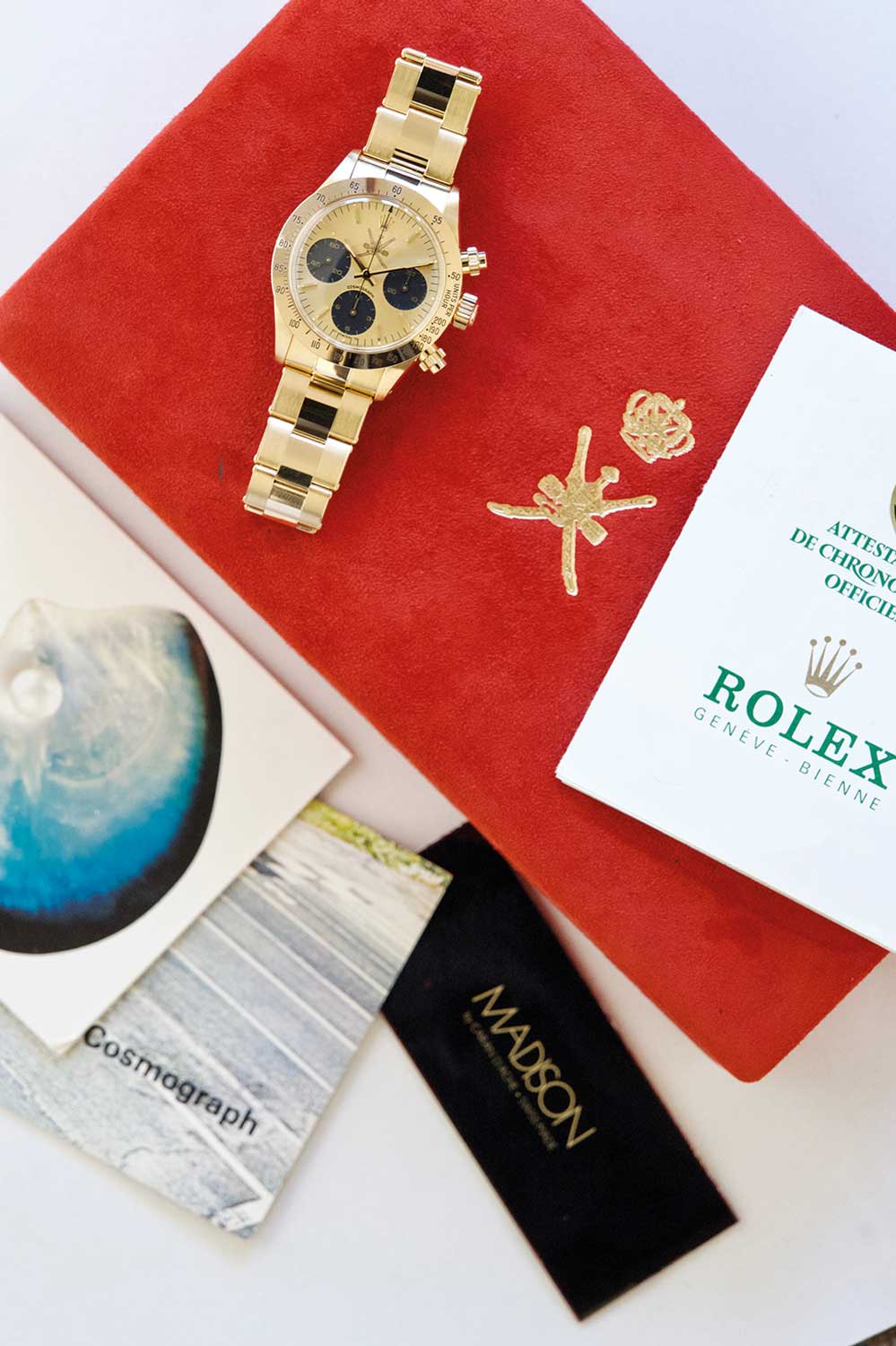
A full-set yellow gold Rolex Daytona reference 6265 delivered to the Sultanate of Oman via Asprey Geneva in a special presentation box with two Caran d’Ache pens
Bourn continues, “The watch collection which started with Patek Philippe in the late 1980s and early ‘90s evolved by the early 2000s to focus on Rolex, particularly vintage pieces with a military connection or so-called special deliveries.” For the last decade, the watch collection has been primarily curated by Bourn who believes that, in terms of diversity and quality, it should be considered as one of the most focused and exceptional collections of vintage Rolex that exists today.
The Oman watches from the collection, some of which are featured here, not only showcase some of the rarest examples of Rolex watches to incorporate the Oman Khanjar insignia, Qaboos signature and Asprey name, but the overall condition and provenance are without equal. Watches from original owners with paperwork and provenance, and original delivery information via Asprey and Khimji Ramdas (Rolex’s official retailer in Oman) are all included, as well watches were issued to the people that received them. Ruled by the Al Bu Sa’idi dynasty since 1744, Oman was once a regional power, with a sultanate that extended to Iran, what we now know as Pakistan, and south to Zanzibar on the east coast of Africa. Over time, its power declined, and it came under the increasing influence of the United Kingdom. It had been under the rule of Sultan Sa’id bin Taimur since 1932. But by the 1960s, whilst still maintaining strong links with the United Kingdom, it was becoming internationally acknowledged that the Sultan was not in control of his own country.
His son, Sultan Qaboos bin Sa’id, born in 1940, attended Sandhurst Military Academy in England at the age of 20 and then joined the British Army. He was posted to the 1st Battalion, The Cameroonians (Scottish Rifles) and served in Germany. He returned to Oman in 1964 where he was placed under house arrest by his father. Six years later in 1970, with the support of the British Special Air Service (SAS), as some untouched and previously unknown examples with unquestionable provenance that demonstrate that they came directly from the Palace of Oman.
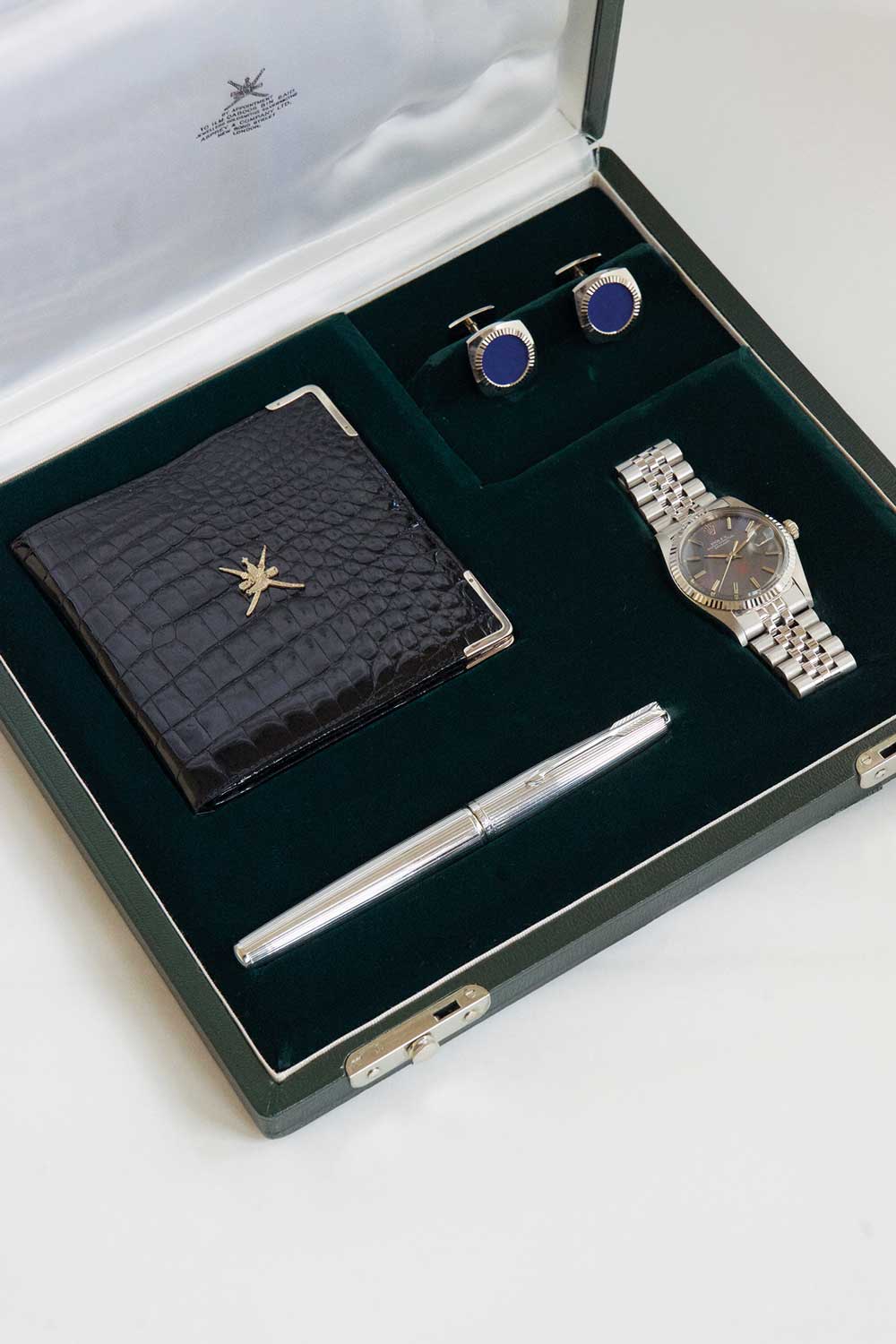
A white gold Rolex Datejust 1601 in special Asprey presentation box with wallet, lapis lazuli cufflinks and pen, all featuring the Khanjar insignia;
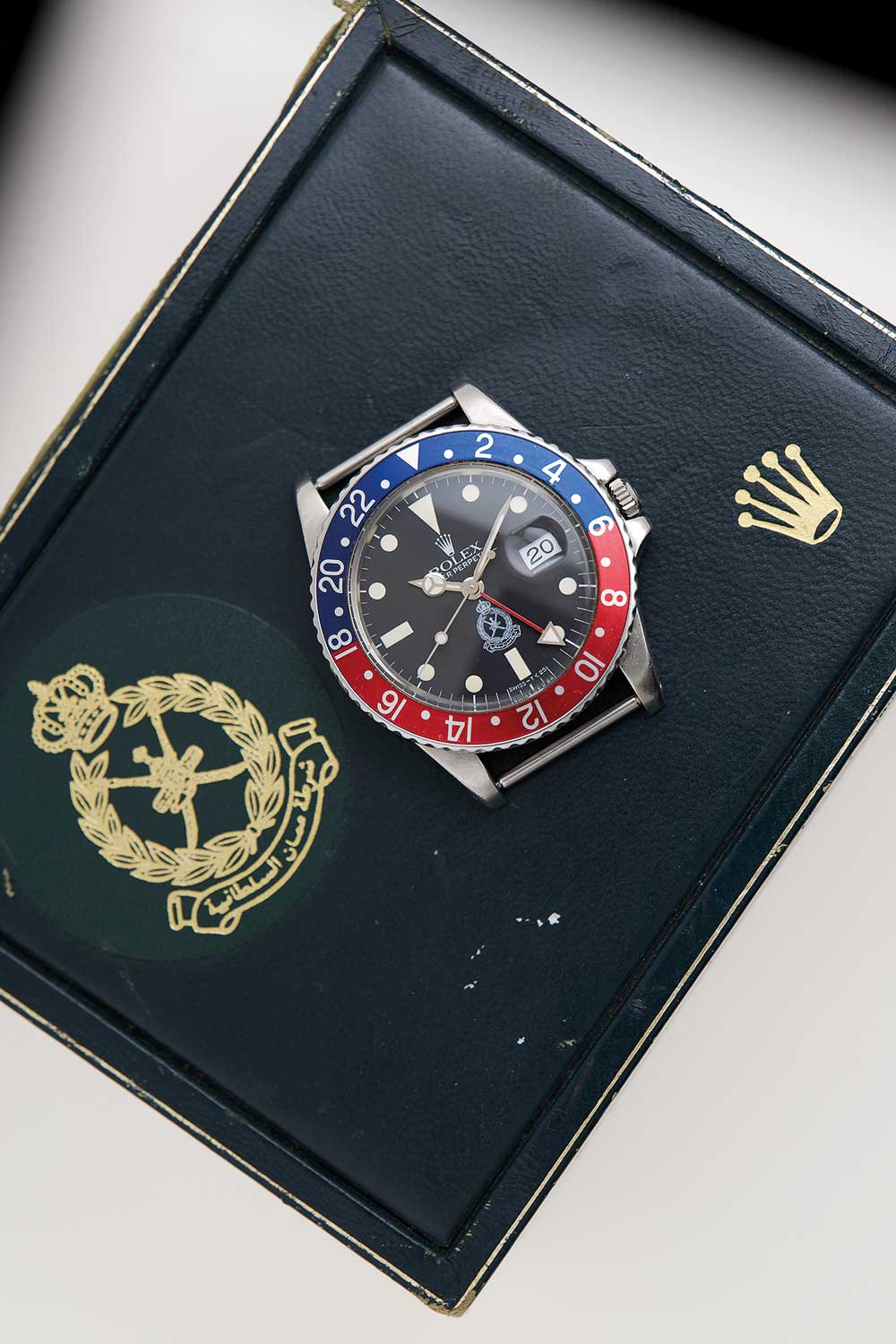
A Royal Oman Police Rolex GMT-Master reference 16750 with Rolex box featuring the Royal Oman Police insiginia
Rise of a New Sultan
Understanding these Omani Rolex watches is a complex field, and many of the sports watches such as Sea-Dwellers and Daytonas exist in known serial number batches with specific dial versions. However, it’s not always this simple, as Bourn has discovered over the many years he has been acquiring the watches for clients. “Collectors like to group things into cohorts of serial numbers and years of delivery but, in actual fact, the reality is that these watches were often ordered, manufactured, assembled and delivered at different times, conflicting with the standard assumed chronology based on date codes and serials.”
Understanding a little about Muscat and Oman, as it was known until 1970, is important to understand how some of the he overthrew his father to take control of the country (the British interest in this was the oil boom in which they wanted a share). On his ascension to the throne in 1970, Qaboos immediately instigated major social, educational and military reforms, with the intention of ending the country’s isolation and using its oil revenue for modernization and development. He also declared that the country would no longer be known as “Muscat and Oman,” but would change its name to “the Sultanate of Oman” in order to reflect its political unity.
This was complemented by a new flag which replaced the traditional white flag that had been used since 1865. The national flag of Oman featured three colors: red for battles against foreign invaders; white to symbolize peace and prosperity; and green for fertility and the Jabal al Akhdar or Green Mountains. The flag also incorporated the national emblem, a Khanjar dagger in a sheath with two crossed swords in the background. Qaboos added a new individual standard for the Sultanate of Oman, which exclusively featured the Khanjar in gold with the Sultan’s Crown above. These specific colors feature heavily on the Oman Khanjar dagger and Qaboos signature which we see are printed on the watch dials and accompanying boxes.
Bourn picks up the story: “Under his father’s reign, a group of rebels had formed in the early 1960s and by the early ’70s, the rebels posed a significant threat to the country. In addition to implementing the necessary reforms to safeguard Oman’s future, Qaboos faced another issue, the Dhofar Rebellion that had commenced in 1962 was growing ever stronger by 1970. The British military commanders in Oman suggested that a ‘hearts and minds’ campaign codenamed ‘Operation Storm’ be put into operation, primarily by operatives from the British Special Forces’ elite 22nd SAS Regiment (Boat, Air, Mobility and Mountain counterterrorism specialists).
“Once ‘Operation Storm’ was underway, many of the Omanis who opposed the Dhofar rebels sided with the SAS, who formed them into ‘counter gangs’ using their superior local knowledge, a strategy that had worked well for the SAS in both Kenya and Malaya. The SAS gradually began to occupy commanding positions on the mountain range throughout the Dhofar region, incurring running battles with the Dhofar rebels as they did.”
Bourn continues, “When the Dhofar Rebellion finally ended in 1976 with the insurgents suppressed, the SAS contingent that had been engaged in the conflict from the time of the coup amounted to around 80 men (supported by Oman locals). The insurgents had numbered almost 15,000, a staggering achievement. The 22nd SAS Regiment went on to engage in countless other anti-terrorist campaigns, and achieved notoriety during the 1982 Iranian Embassy siege which was broadcast worldwide.”
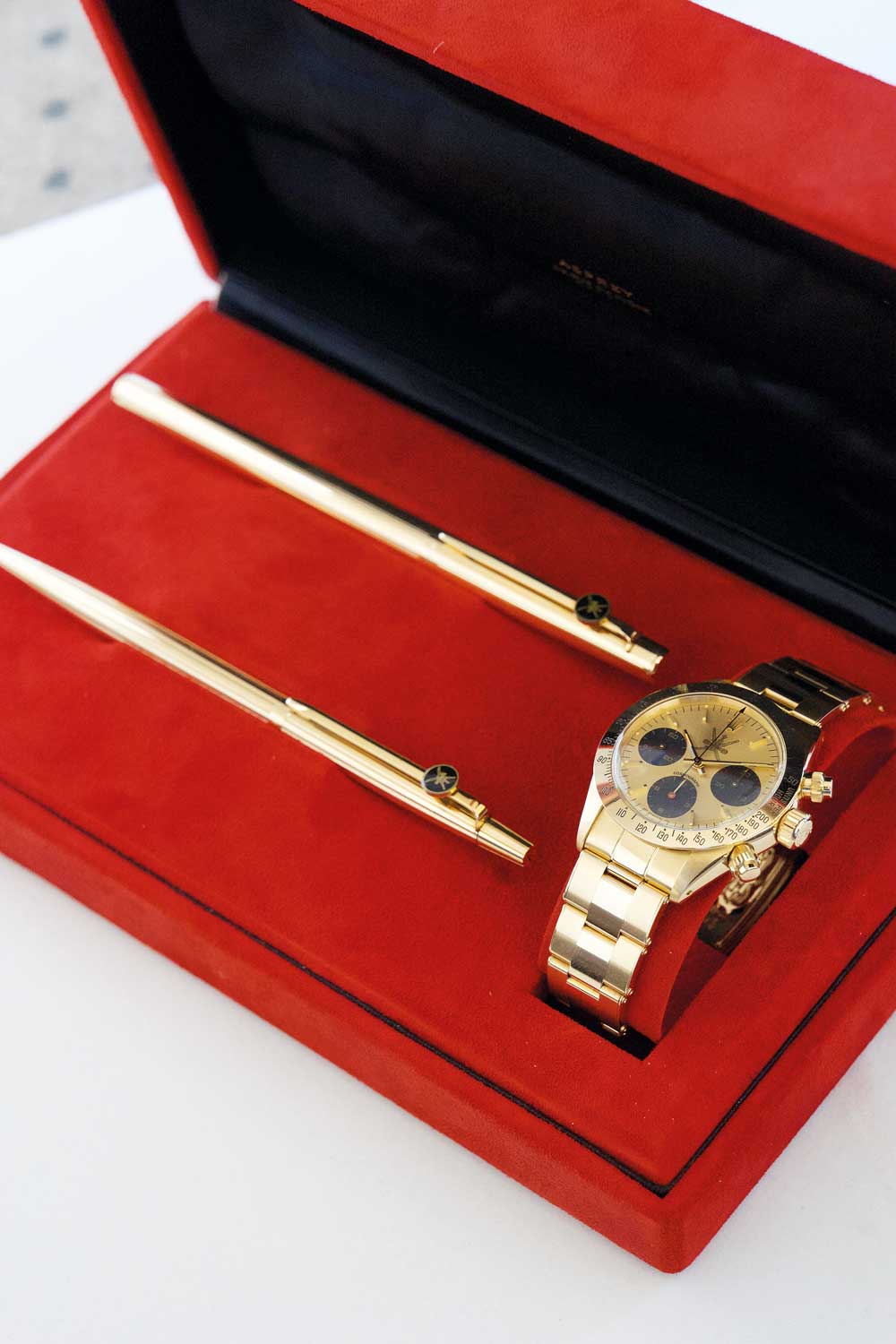
Both Caran d’Ache pens in this Daytona 6265 set feature the Omani Khanjar insignia
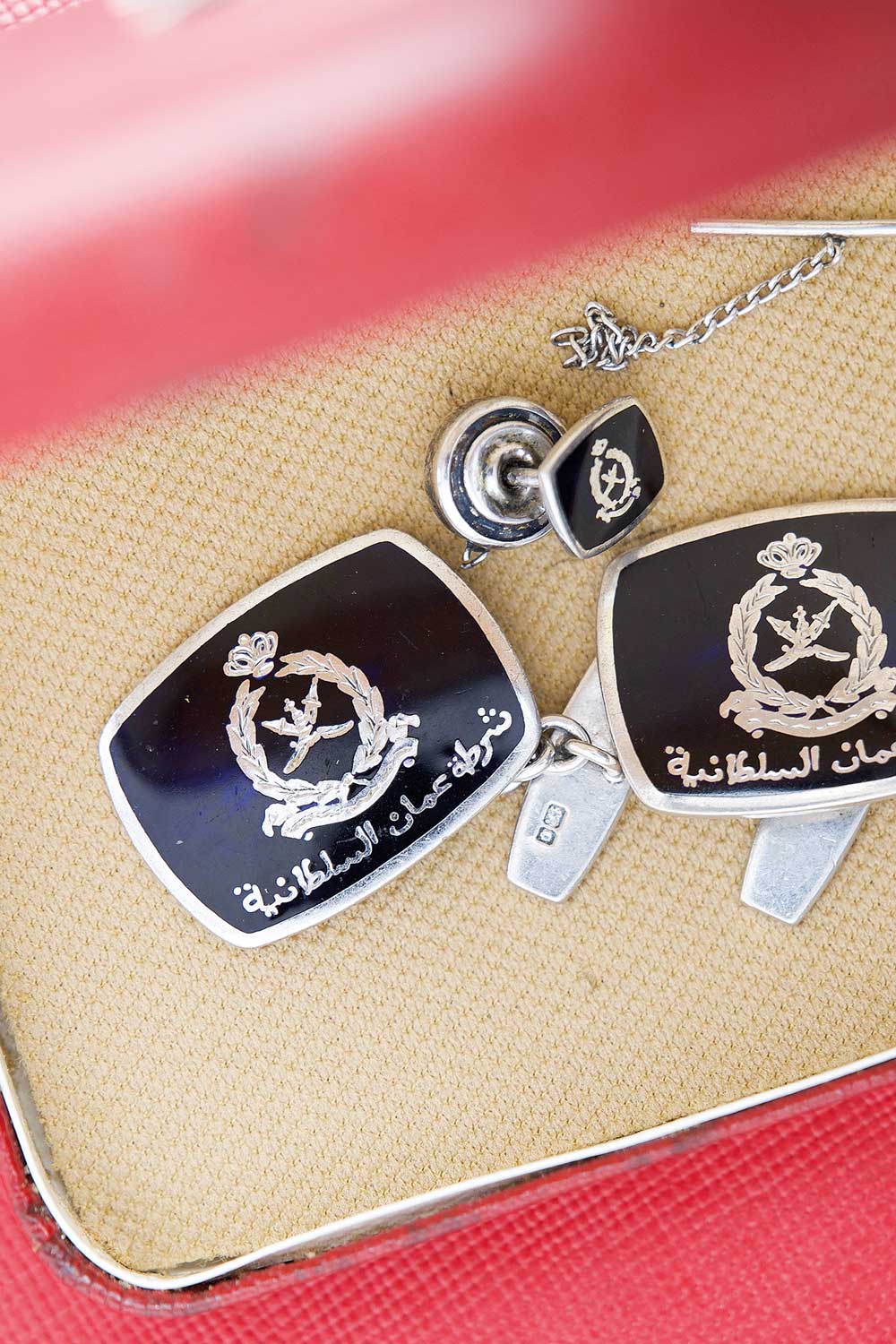
Cufflinks and tie-pin featuring the Omani Khanjar insignia
Rolex Red “Oman Khanjar and Qaboos” Sea-Dwellers
The Rolex 1665 Omani Sea-Dwellers with either red Khanjar or Qaboos dial script, were commissioned by Sultan Qaboos bin Sa’id via Asprey of London in the early 1970s. Evidence exists that they were presented to the British military’s SAS troops who had served in Oman during the Dhofar Rebellion between 1970 and 1976. Key characteristics of the watches are that the so-called “Double Red” lines, depth rating and SCOC (Superlative Chronometer Officially Certified) found on the standard 1665s of the period are absent and, in their place, was the Omani Khanjar or Qaboos signature in bright red script. Research and experience indicate that the tritium on the hour markers was very heavily applied and often develops a strong and particularly attractive patina.
It is noteworthy that the serial numbers of known watches for Sea Dwellers are all with a small serial number run of 3.56 million and have the full serial engraved inside the caseback. The outer caseback has the expected straight “Rolex” style engravings of the period, but also carries the Asprey engravings in the lower center.
Says Bourn, “Following a comprehensive study of the known serial numbers, I believe that up to 100 examples were produced in a consecutively numbered batch starting with serial 3566,9xx and ending at 3567,0xx. Of these estimated 100 examples, approximately 30 percent are now known. The known watches feature a fairly equal mix of either red Khanjar or Qaboos dials and have been fitted in a random sequence. We see consecutive serials with either dial, and then small batches of three to four watches with one dial type or the other. Of the Sea-Dwellers within this batch that have surfaced to date, the red Khanjar insignia is found in slightly greater numbers.”
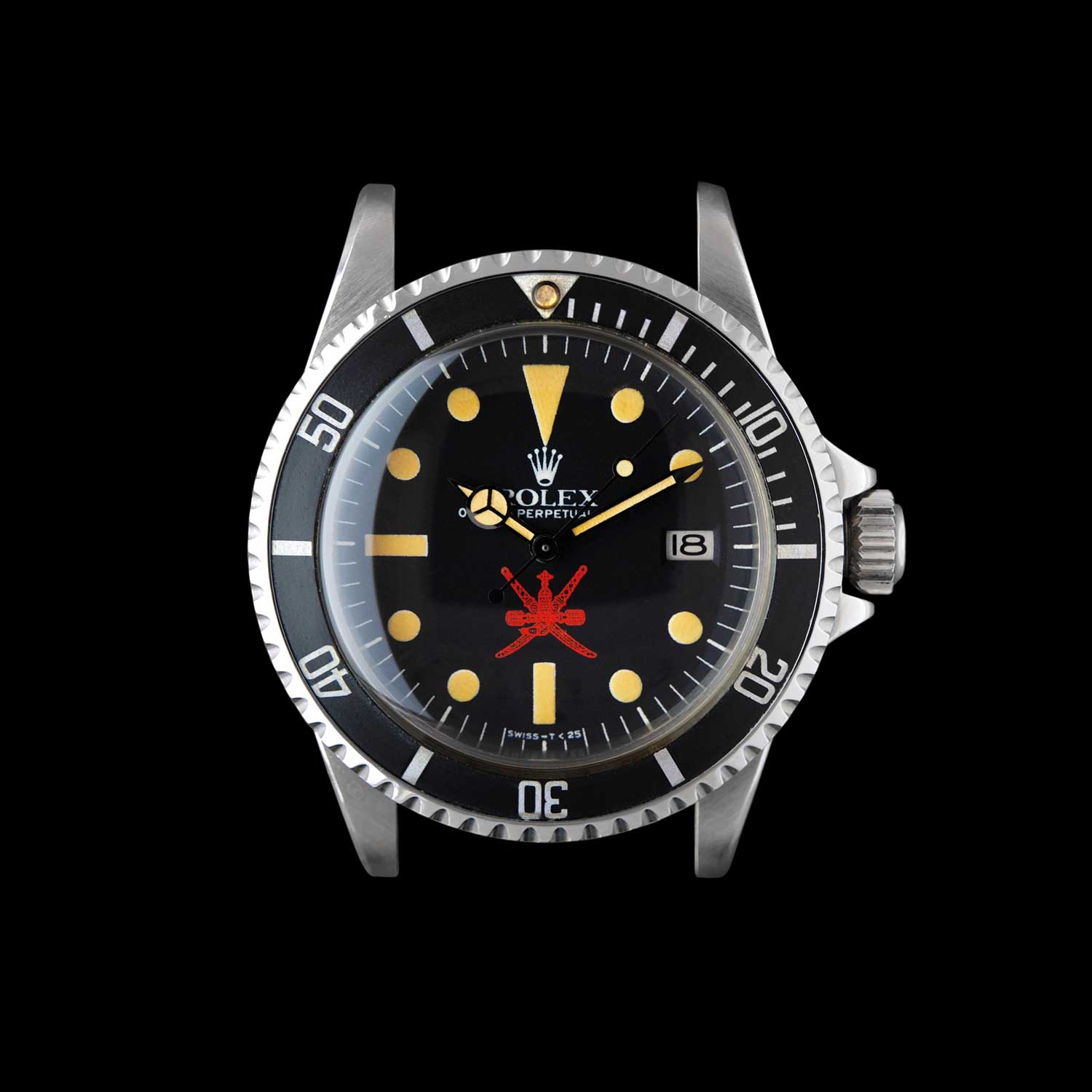
STAINLESS STEEL ROLEX SEA-DWELLER REF. 1665 with red Khanjar insignia instead of the usual “Double Red” model designation and depth rating. The outer caseback is engraved “Asprey.” This is a full box set with matching numbers and was from a batch of approximately 100 watches with consecutive serial numbers delivered to Oman via Asprey London, circa 1974
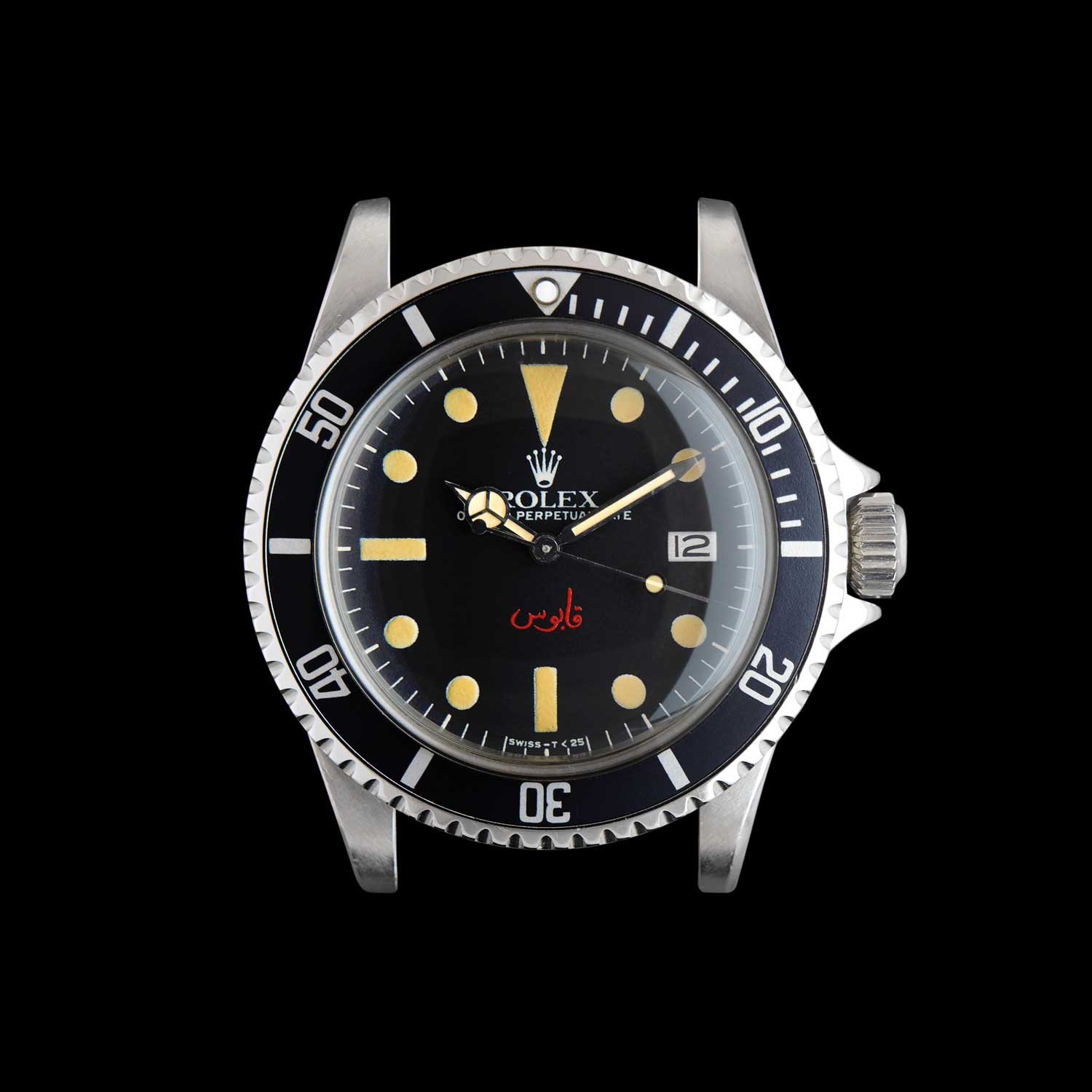
STAINLESS STEEL ROLEX SEA-DWELLER REF. 1665 with red Qaboos signature instead of the usual “Double Red” model designation and depth rating. The outer caseback is engraved “Asprey.” This is a full box set with matching numbers and was from a batch of approximately 100 watches with consecutive serial numbers delivered to Oman via Asprey London , circa 1974
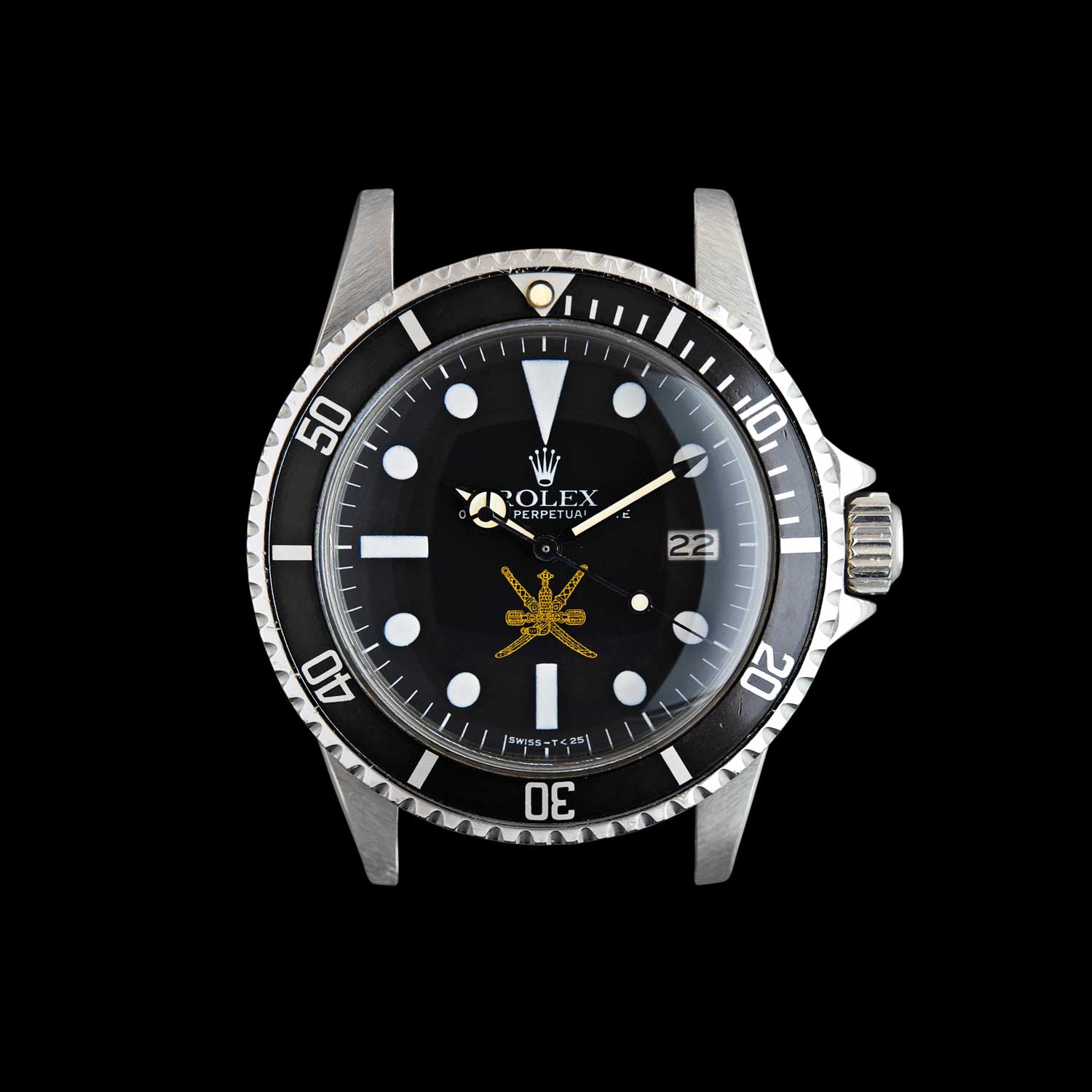
STAINLESS STEEL ROLEX SEA-DWELLER REF. 1665 with gold Khanjar insignia instead of the usual “Double Red” model designation and depth rating. This is a set with matching numbers. It is one of five known examples delivered, circa 1978
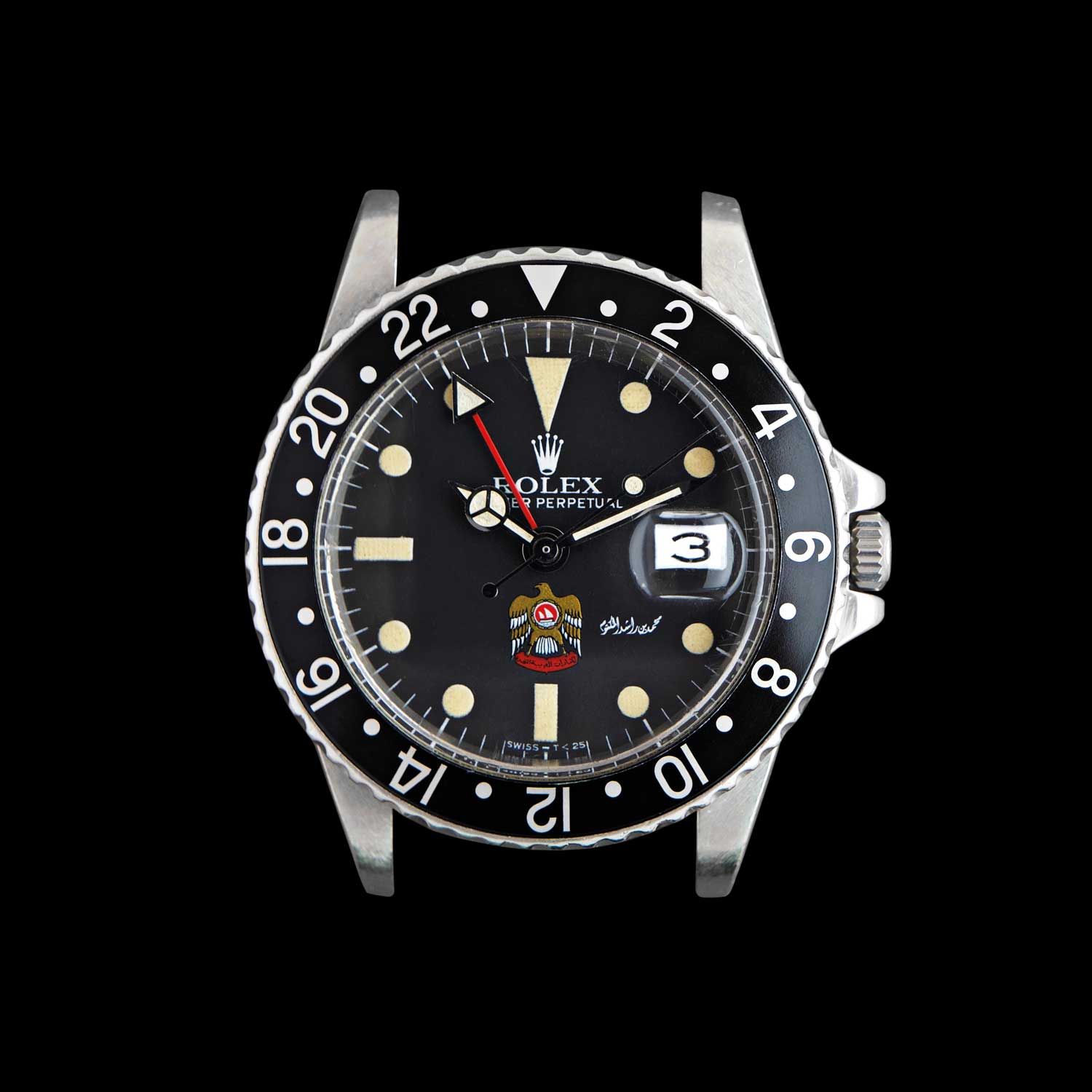
STAINLESS STEEL ROLEX GMT-MASTER REF. 1675 with UAE Quraysh hawk replacing the usual model designation and SCOC text on the dial. This is a set with matching numbers. It was a special order by Sheikh Maktoum bin Rashid al Maktoum, circa 1978
Rolex Gold “Oman Khanjar” Sea-Dwellers
There are four known examples of the Rolex 1665 Omani Sea-Dwellers with a gold Khanjar emblem on the dial. Much like their red Khanjar cousins, the lines and text found on the standard 1665s of the same eras are absent and in place there is an Omani Khanjar in gold script. Interestingly, the Rolex coronet on the dial is a unique style and different to the Rolex 1665 Oman red Khanjar or other coronets on the Double Reds of the period. Another big difference to the red Khanjar 1665s, is that the tritium application on the hour markers is absent or minimally applied. The gold Khanjar Sea-Dwellers were delivered later (circa 1978) with serial numbers all in the five million range and, according to Bourn, “all but one of the known examples also has the serial number in the caseback, which would normally indicate that either the caseback on that particular example was changed at some point during service, or the dial was fitted later.”
So, why were some made with gold Khanjar logos? Bourn believes that some of these watches were given to those deemed especially worthy. “Using the historical information provided earlier of Oman during the period [from] 1970 to 1976, we know that the gold Khanjar was used only to represent the Sultanate of Oman on the Sultanate’s official standard, whereas the national flag features the Khanjar in white. If the use of red on the red Khanjar and Qaboos Sea-Dwellers is as we believe significant, it would suggest the use of gold here would also be — possibly to indicate a special presentation directly by Sultan Qaboos himself. A recent example of a Rolex 1665 Sea- Dweller with gold Omani Khanjar that surfaced directly from the family of the first owner confirmed via extensive documentation that it was gifted by the Sultan to a US naval pilot who also received ‘The Order of the Special Royal Emblem’ by the Sultan of Oman in recognition of his services to the Sultanate of Oman as a member of the Royal Oman Police, which included search and rescue operations involving a Royal Oman helicopter crash.”
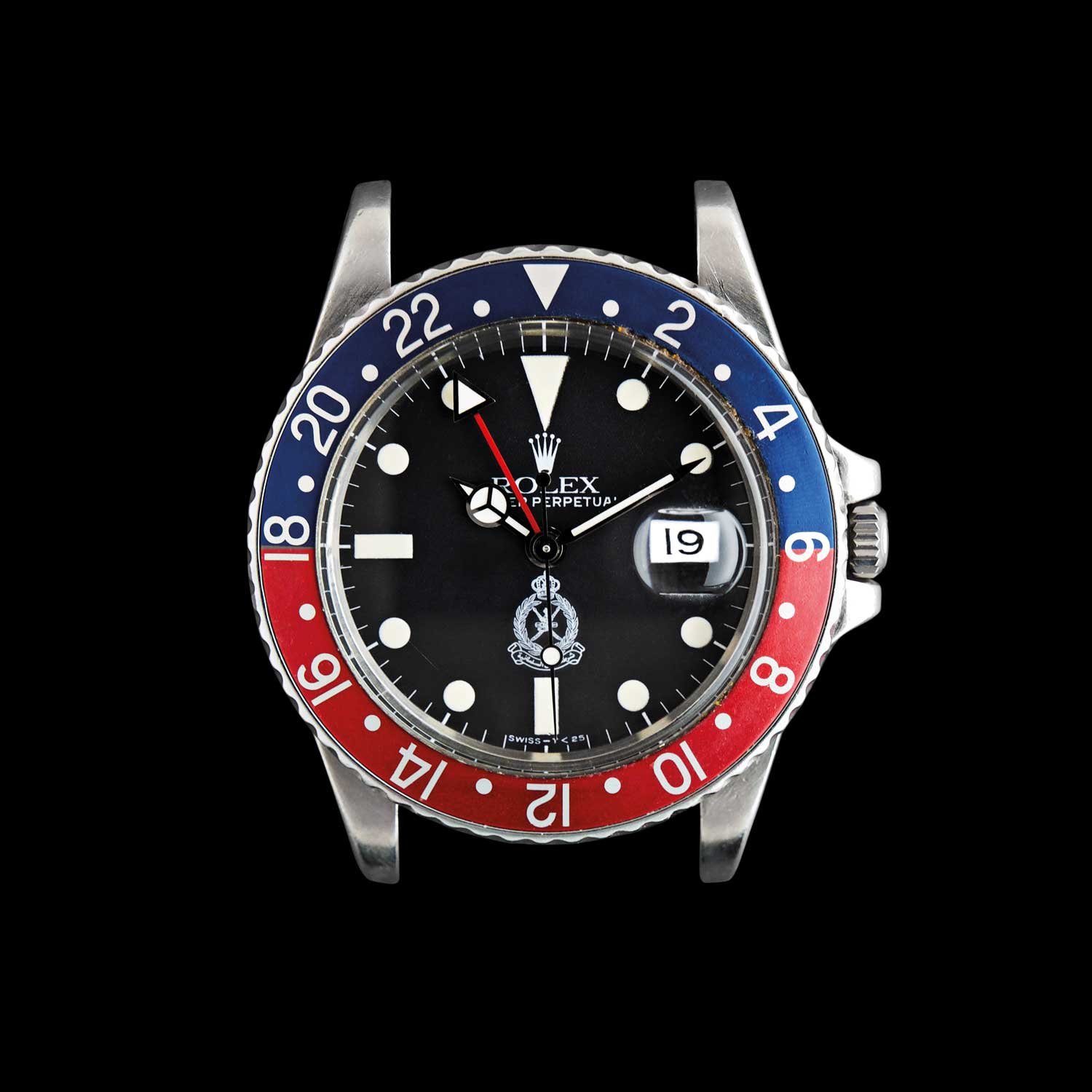
STAINLESS STEEL ROLEX GMT-MASTER REF. 16750 with the Royal Oman Police logo replacing the usual model designation and SCOC text on the dial. This is one of only five known examples. Delivery to the Sultanate of Oman, circa 1983, was confirmed by Rolex Genève
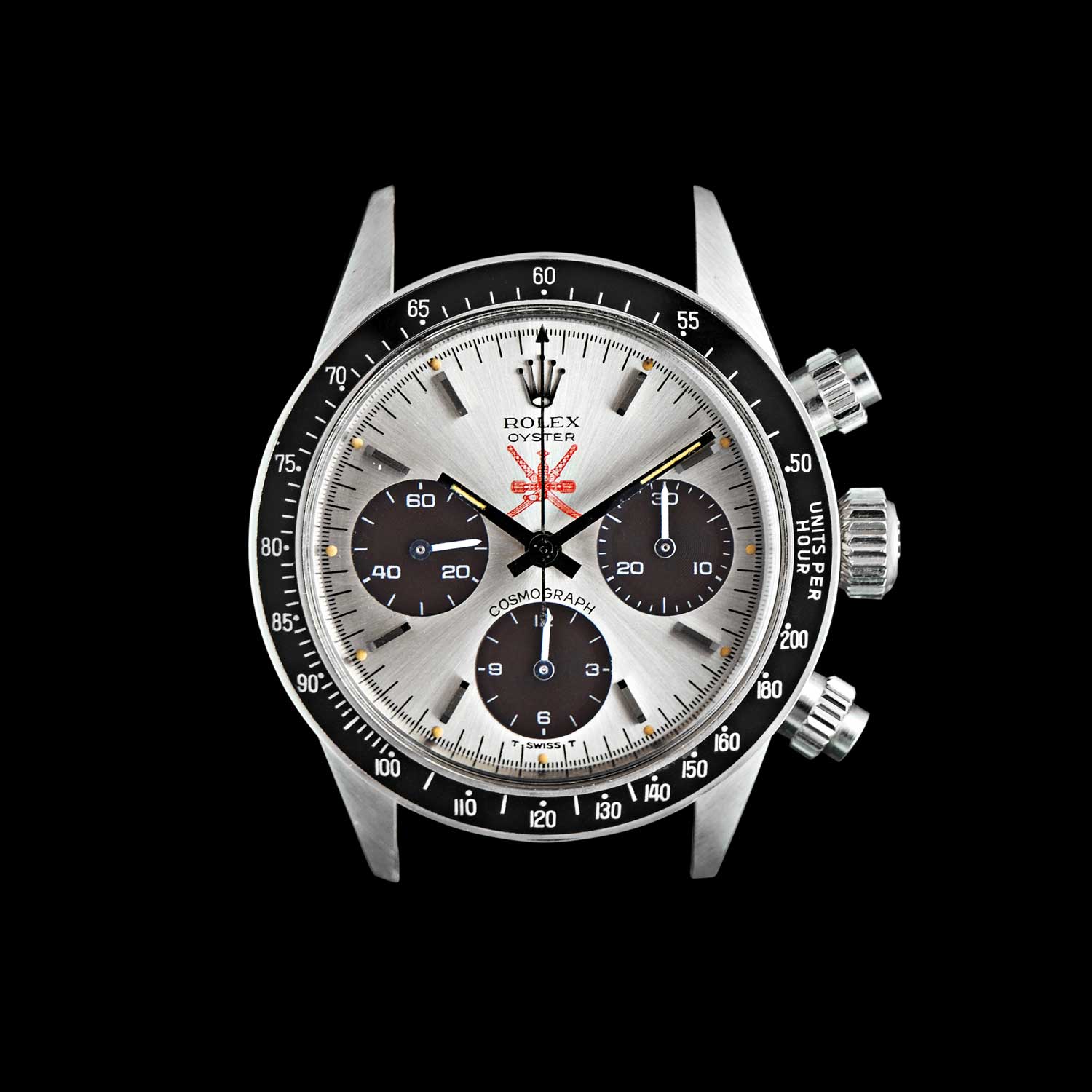
STAINLESS STEEL ROLEX DAYTONA REF. 6263 with red Khanjar insignia. The outer caseback is engraved “Asprey.” It was delivered to Oman via Asprey London, circa 1975
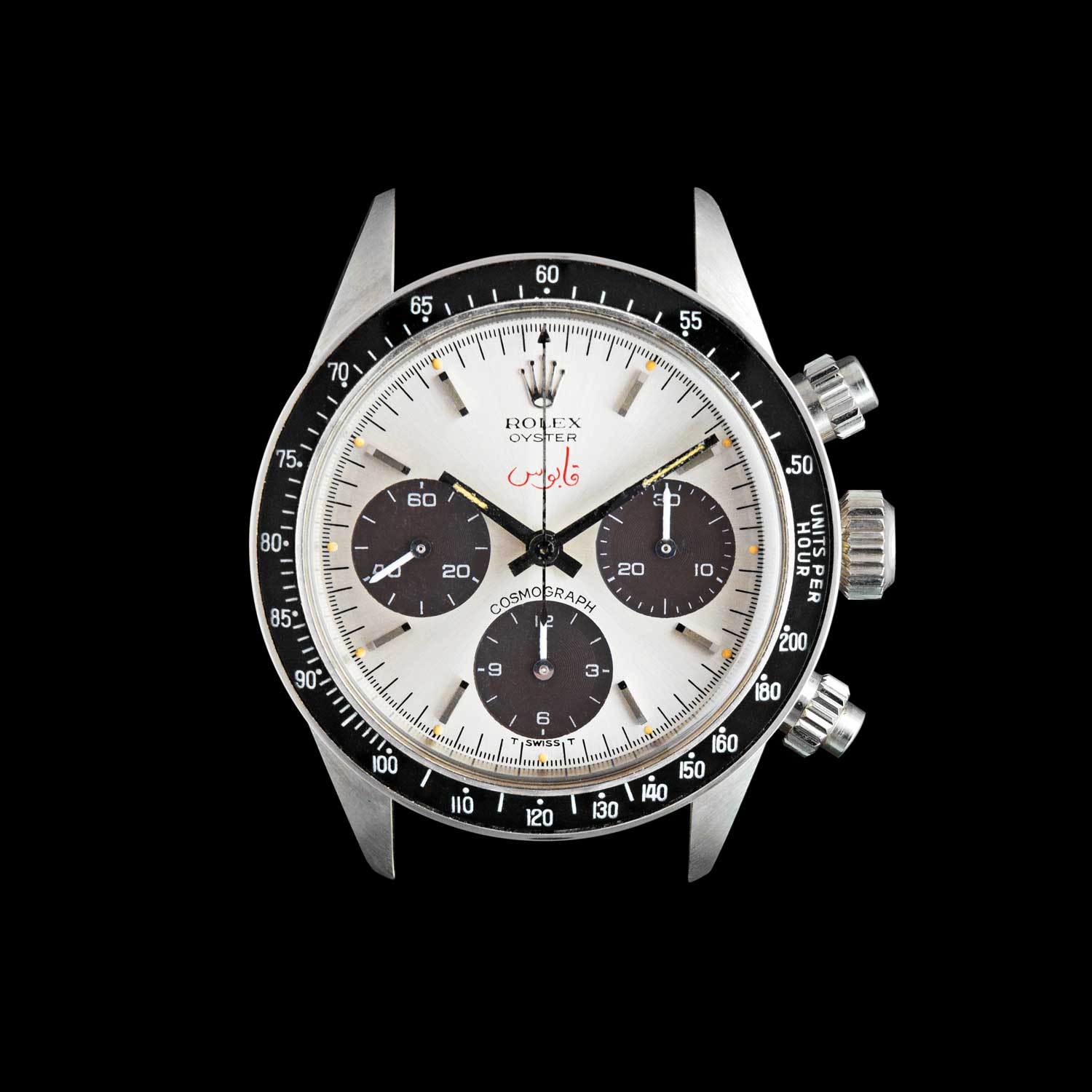
STAINLESS STEEL ROLEX DAYTONA REF. 6263 with red Qaboos signature and tropical subdials. The caseback is engraved “Asprey.” It was delivered to Oman via Asprey London, circa 1975
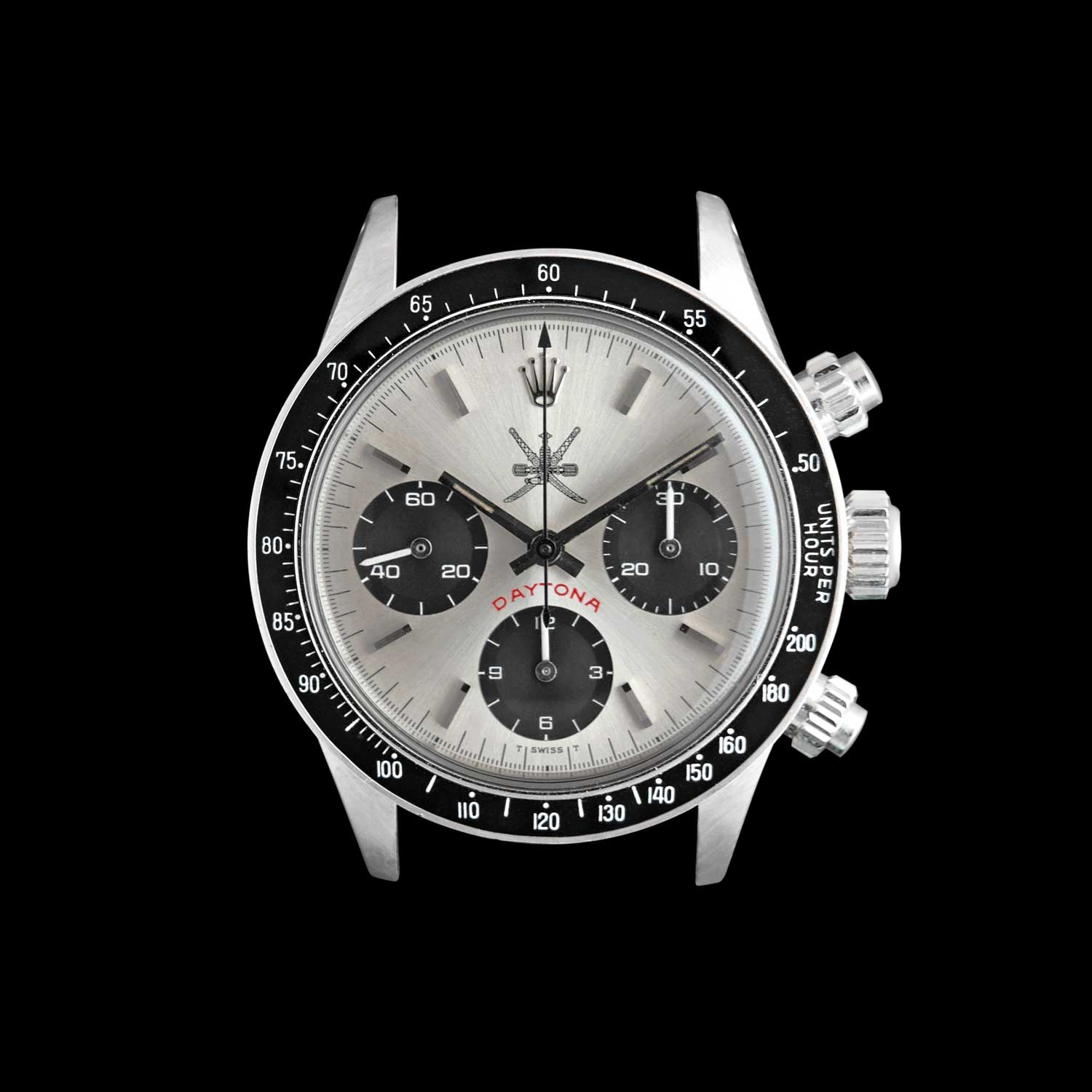
STAINLESS STEEL ROLEX DAYTONA REF. 6263 with gray Khanjar insignia. This watch was delivered to Oman via Khimji Ramdas, circa 1980. Delivery was confirmed by Rolex Genève
Daytonas, Day-Dates and Datejusts
Aside from the aforementioned Sea-Dwellers, a good number of other Rolex watches were given as gifts. It is key to remember that Sultan Qaboos bin Sa’id was one of the world’s most prolific collectors and commissioners of watches and so he gained huge pleasure from this element of his life. Beautiful watches, especially pieces by Rolex, were his favorite gift to people including businessmen, military officials and those deemed to have provided a valuable service to the Sultanate of Oman.
Over his career, Bourn has conducted a lot of research into the Rolex watches that were ordered and often presented as gifts by the Sultan of Oman. He comments, “There is a custom in the Gulf of presenting gifts, often watches, in recognition of achievements, appreciation, or as a mark of respect. The Sultan was one of the great watch collectors, ordering custom watches featuring either the Omani Khanjar or his own signature on the dials, via Asprey London in the 1970s and early ’80s, on rare occasions from Asprey Genève (the few known have become extremely coveted by collectors) and later via Khimji Ramdas. The Sultan would on occasions present the watches as gifts to loyal staff, foreign dignitaries and those that had provided a great service to the Sultanate of Oman. These would include members of his own and also foreign military forces. To collectors, the most interesting were those gifted to the British Special Forces and high- ranking military officers in the mid-1970s and early ’80s.”
Check them out below.
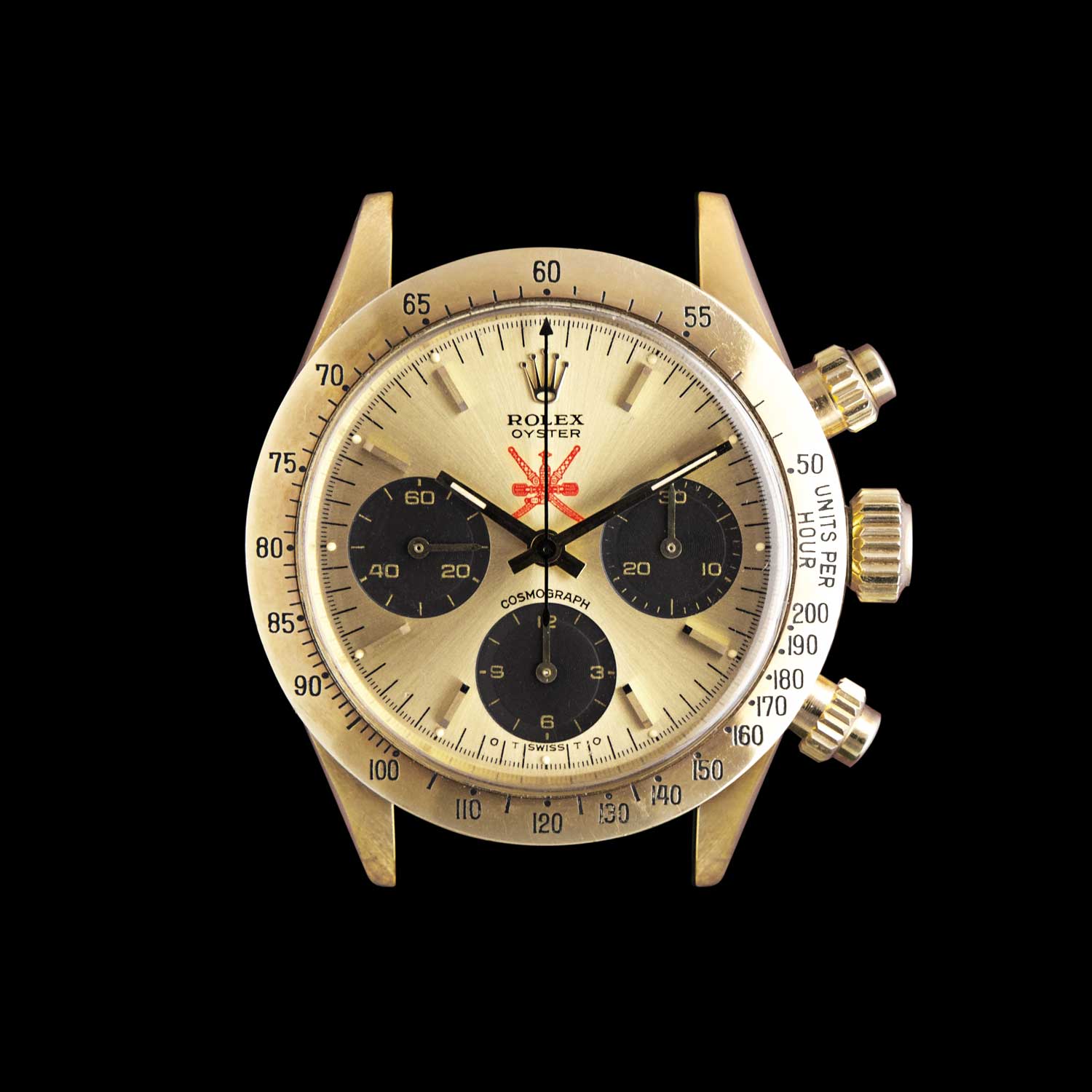
YELLOW GOLD ROLEX DAYTONA REF. 6265 with red Khanjar insignia. The caseback is engraved “Asprey.” This watch was delivered to Oman via Asprey London, circa 1975
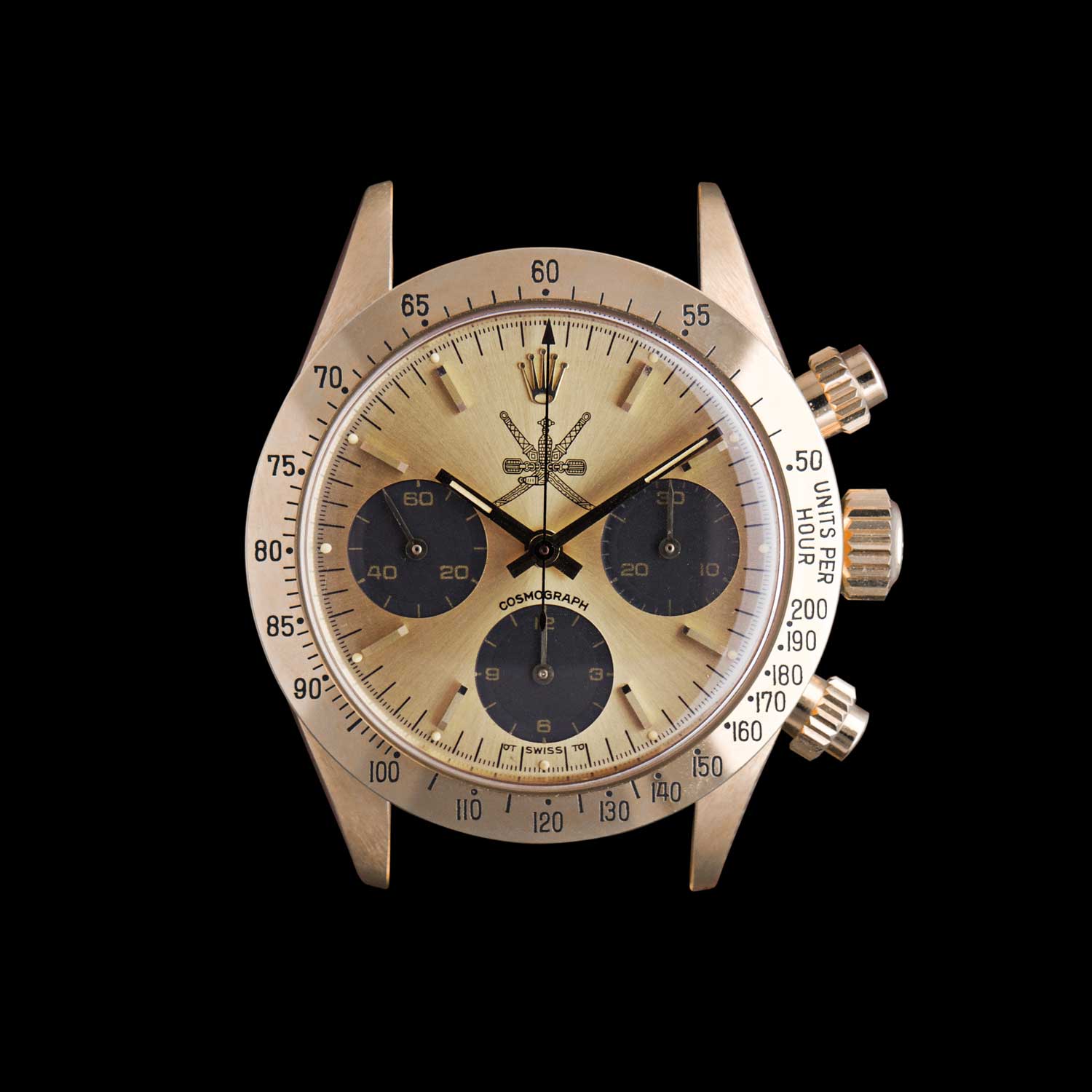
YELLOW GOLD ROLEX DAYTONA REF. 6265 with gray Qaboos signature replacing the usual Rolex text. The caseback comes with the original Rolex 6265 sticker. This is one of the few known watches delivered to the Sultanate of Oman via Asprey Genève, circa 1978, with red suede Khanjar/Asprey Genève box, papers with Asprey Genève stamp and applied Khanjar logo Caran d’Ache pens
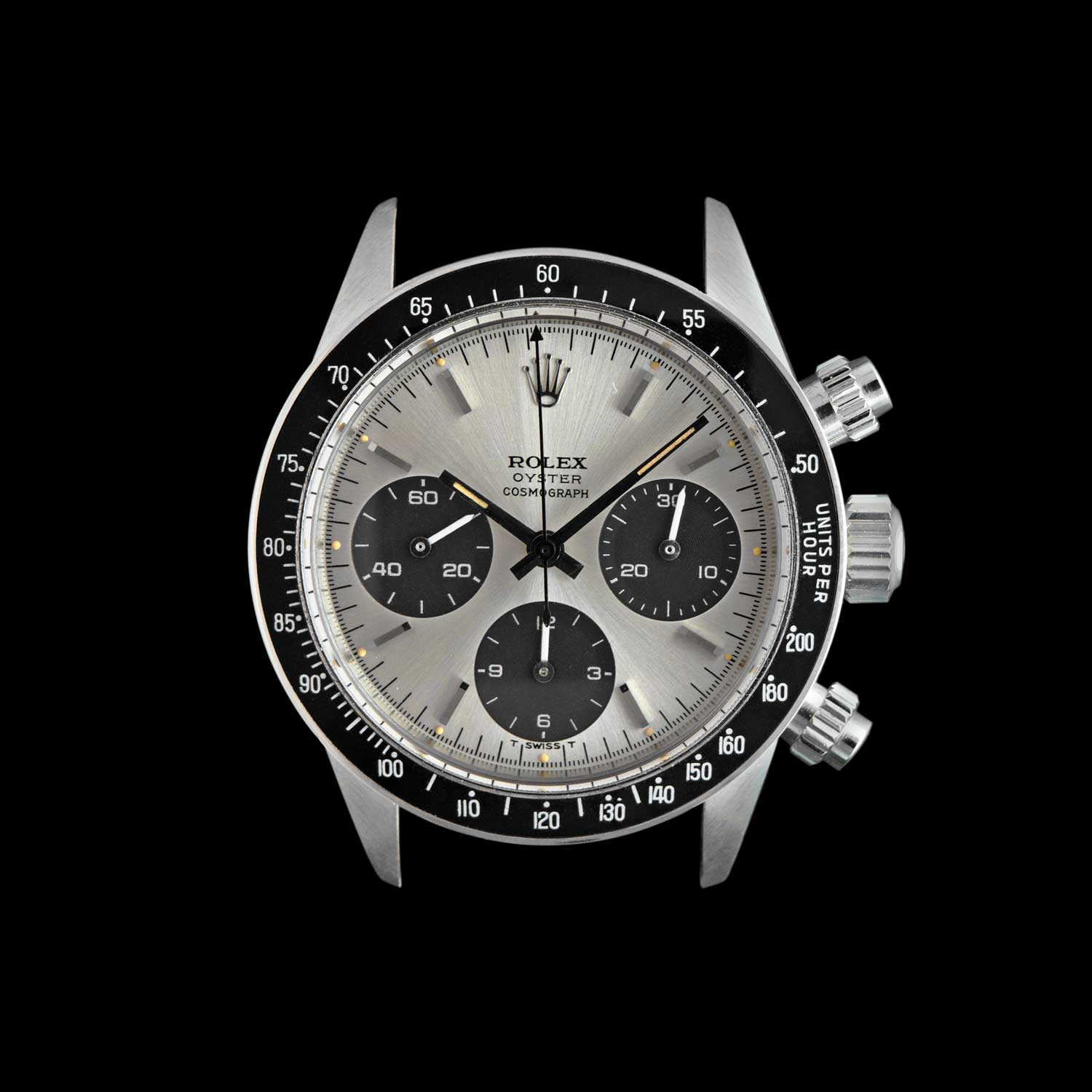
STAINLESS STEEL ROLEX DAYTONA REF. 6263 with silver dial. The caseback is engraved “Asprey.” This watch was delivered to Oman via Asprey London, circa 1975
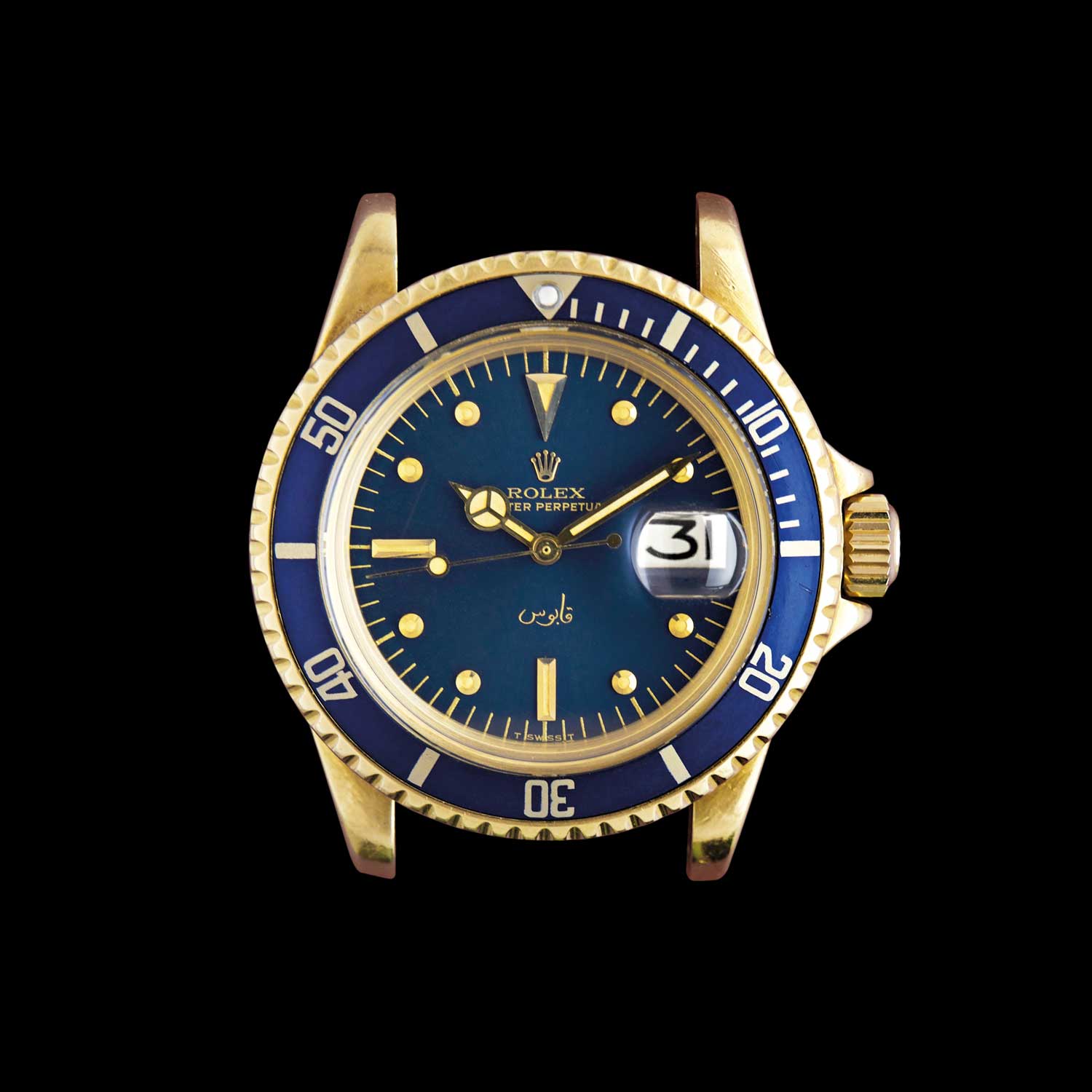
YELLOW GOLD ROLEX SUBMARINER REF. 1680 with gold Qaboos signature replacing the usual SCOC text on an immaculate blue dial, circa 1974
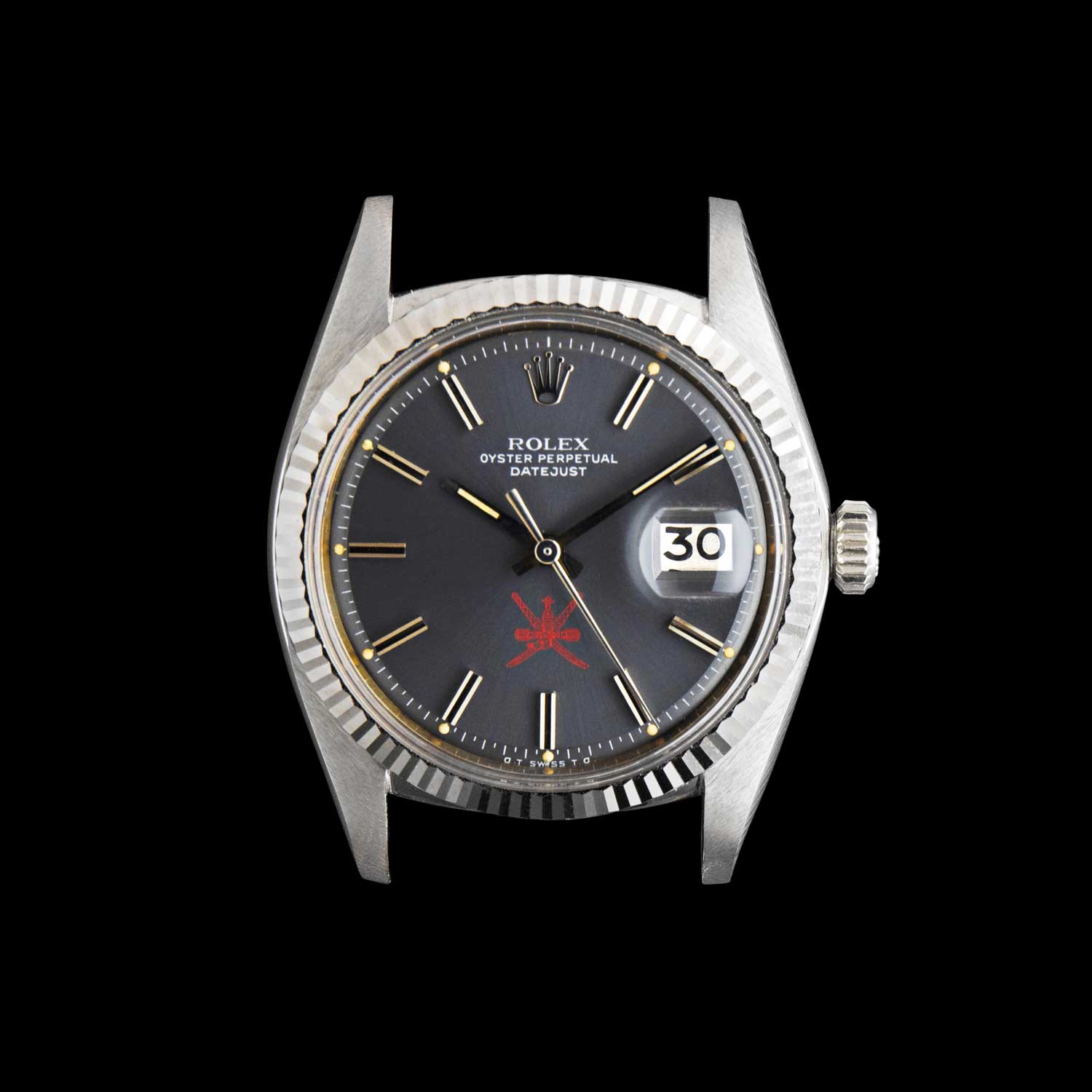
WHITE GOLD ROLEX DATEJUST REF. 1601 with red Khanjar replacing the usual SCOC text. It was delivered to Oman via Asprey London, circa 1975, as a special presentation box set including a green outer box with Khanjar insignia and Asprey logo, crocodile wallet and lapis lazuli cufflinks, all featuring the Oman Khanjar insignia
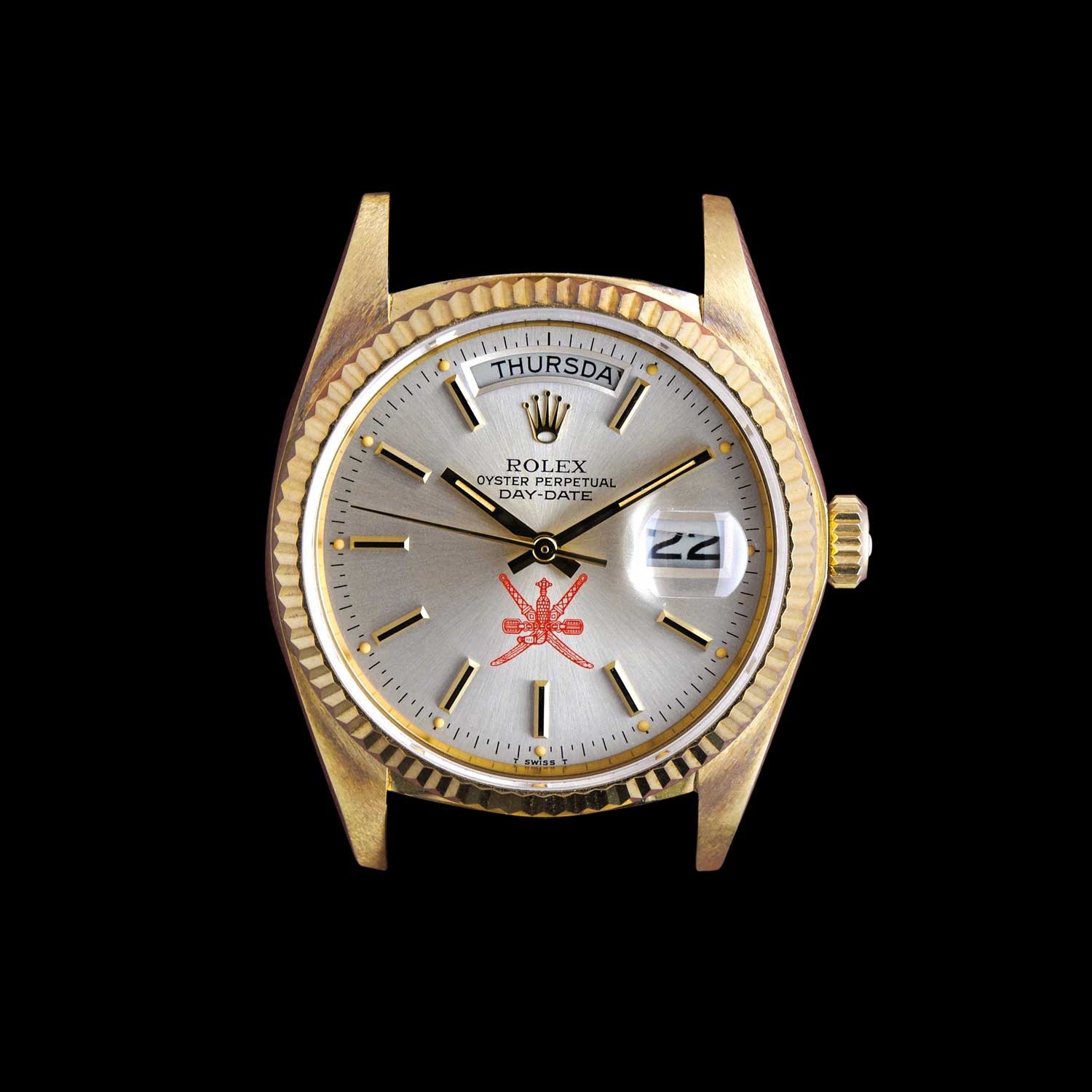
YELLOW GOLD ROLEX DAY-DATE REF. 18038 with red Khanjar replacing the usual SCOC text. The original Rolex 18038 caseback sticker is intact. This watch was delivered circa 1981
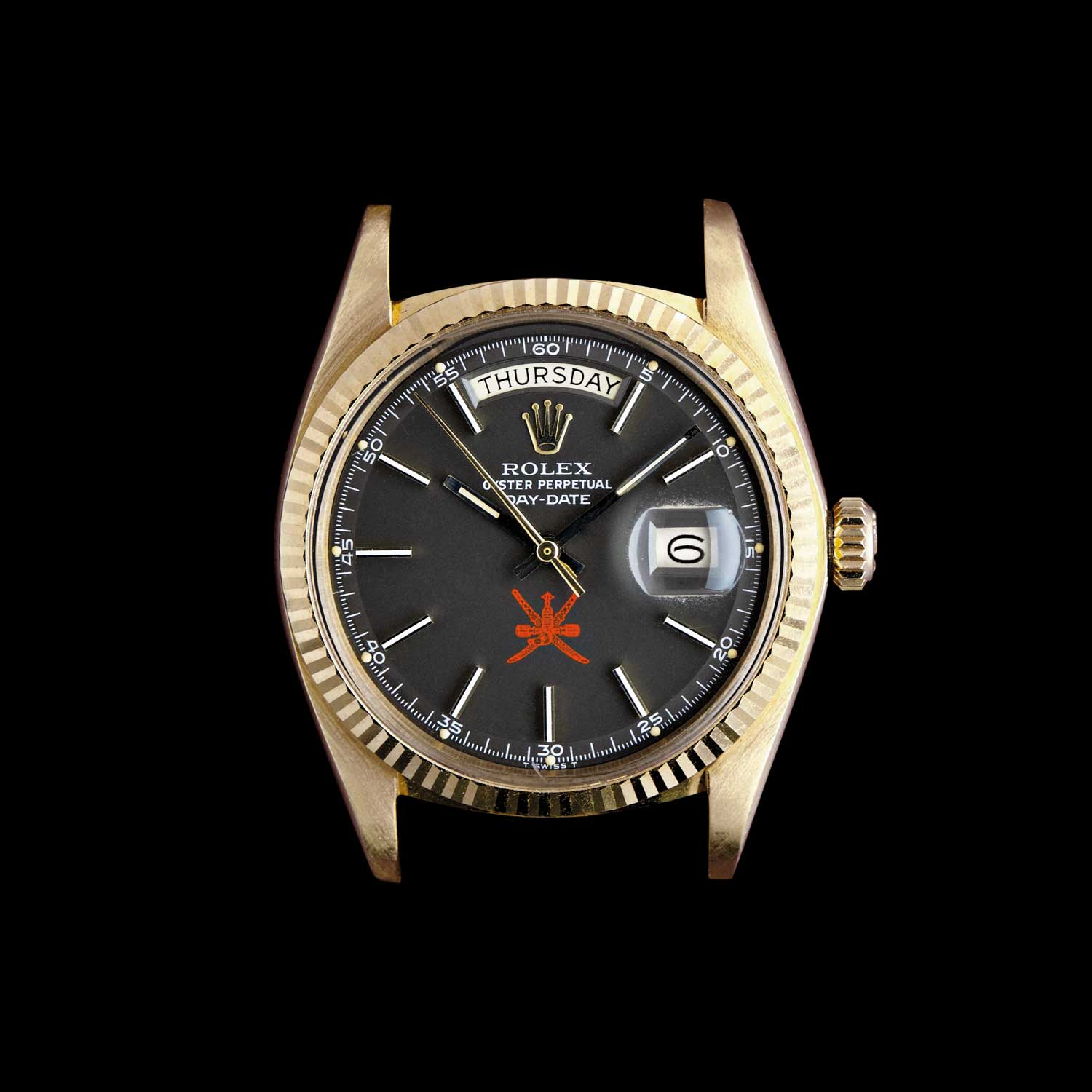
ROSE GOLD ROLEX DAY-DATE REF. 1803 with red Khanjar replacing the usual SCOC text. This watch was delivered circa 1974
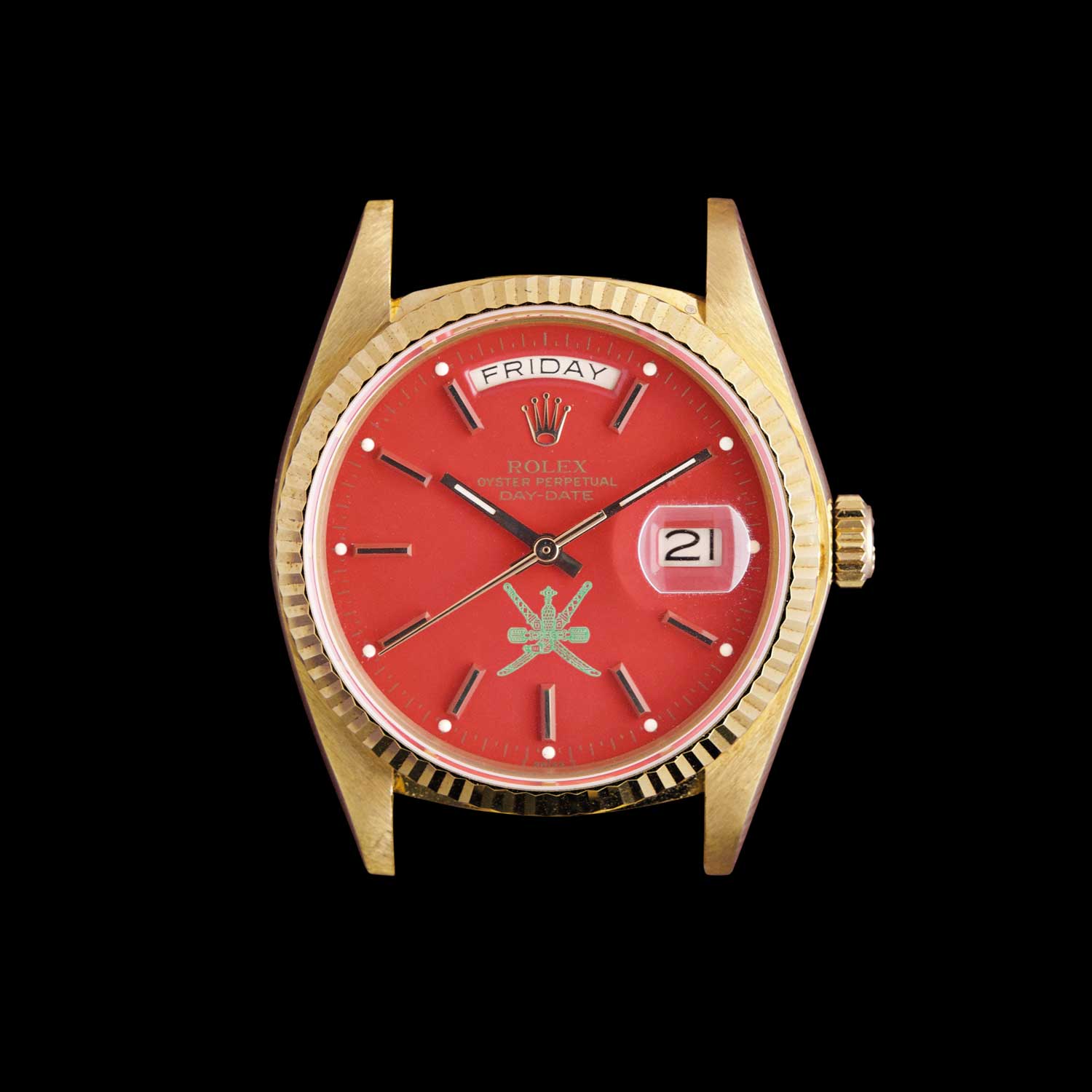
YELLOW GOLD ROLEX DAY-DATE REF. 18038 with green Khanjar replacing the usual SCOC text on an immaculate red “Stella” dial. This is a full box set with documented provenance that it was presented as a gift to a member of the British military for services to the Sultanate of Oman, circa 1982










